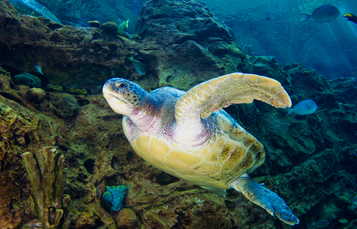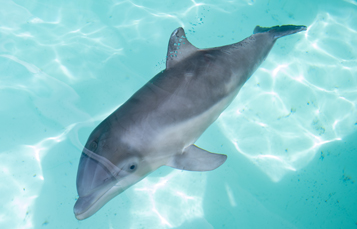Turtle Reef Turns Tide on Zero Waste with First of its Kind Zoological Bio-Filtration System
May 13, 2019May 13, 2019
Reduce, Reuse and Recycle is a mantra typically directed at curbing plastic use, preventing debris and pollution from clogging our environment
SeaWorld, however, also realized these guidelines can help protect one of the planet’s most precious resources: water. With the need for sustainable waste and water management more pressing than ever, SeaWorld San Antonio unveiled a natural biofiltration system last week for its Turtle Reef habitat. The system, a first of its kind in a zoological setting, mimics a wetlands ecosystem as a natural filter –reducing energy costs and setting a new gold standard for sustainable water use.
On average, Americans use over 85 gallons of water each day, while up to a trillion gallons are wasted each year on leaky faucets, malfunctioning toilets and overall excessive use. Meanwhile, over 780 million people worldwide lack access to a clean water supply. SeaWorld’s biofiltration system is part of the park’s dedicated efforts to embrace sustainable innovations that conserve water resources and reduce harm to global ecosystems.
“Not only is the biofiltration system cutting our energy and water use – it benefits the animals, too,” said Joe Keyon, SeaWorld San Antonio’s curator of animal habitats. “It mimics what’s already occurring in nature.”
Within the Turtle Reef habitat, endangered and rescued sea turtles live in a 126,000-gallon coral reef-themed, multi-species environment. Water from the habitat floods through the adjacent filtration system: a planted, 2,100-square foot salt marsh wetlands environment.
“It was challenging for us to determine how exactly to construct this environment, because we hadn’t seen this particular system in an aquarium setting,” said Keyon. “We had to calculate a number of factors, including how deep it needed to be, how to control its flow and even how many plants we’d need to filter the waste.”
As the water flows throughout the system, bacteria living among the plant roots feed on waste produced by the animals. This process filters the water for re-use as it drains out of the wetlands and back into the habitat.
This system is one of the latest of SeaWorld’s efforts to conserve water and cut back on waste. In fact, its parks boast some of the most advanced water purification infrastructures in the world and use these systems to reclaim and recycle wastewater. In several of the parks, for example, landscaping is watered using harvested rainwater and condensate from freezers and buildings.
Another notable aspect of Turtle Reef is the partnership between SeaWorld San Antonio and The University of Texas Marine Science Institute’s Amos Rehabilitation Keep (ARK). SeaWorld San Antonio supports and assists ARK with the rescue of green sea turtles on the Texas coastline.
Chris Havel, SeaWorld San Antonio’s senior aquarist, hopes Turtle Reef will teach guests about sea turtle conservation and the role wetland ecosystems play in balancing their environment.
“Turtle Reef gives guests an up-close look at endangered and rescued sea turtles,” said Havel. “I hope they come away from the experience with a better understanding of how each of us can do our part to reduce human impact that threatens these turtles in the wild.”
Turtle Reef’s groundbreaking filtration system is stemming the tide on water waste, all while sustaining a thriving population of turtles and fish. But there may be more in store for Texas’ newest wetlands. Keyon and his team ultimately hope that the marshland will attract additional wildlife, helping to complete the ecology circle.



.ashx?version=1_202404022246&h=468&w=766&la=en&hash=8DE65BD619660B17C9F60D61E7DCD1D3C7809F39)